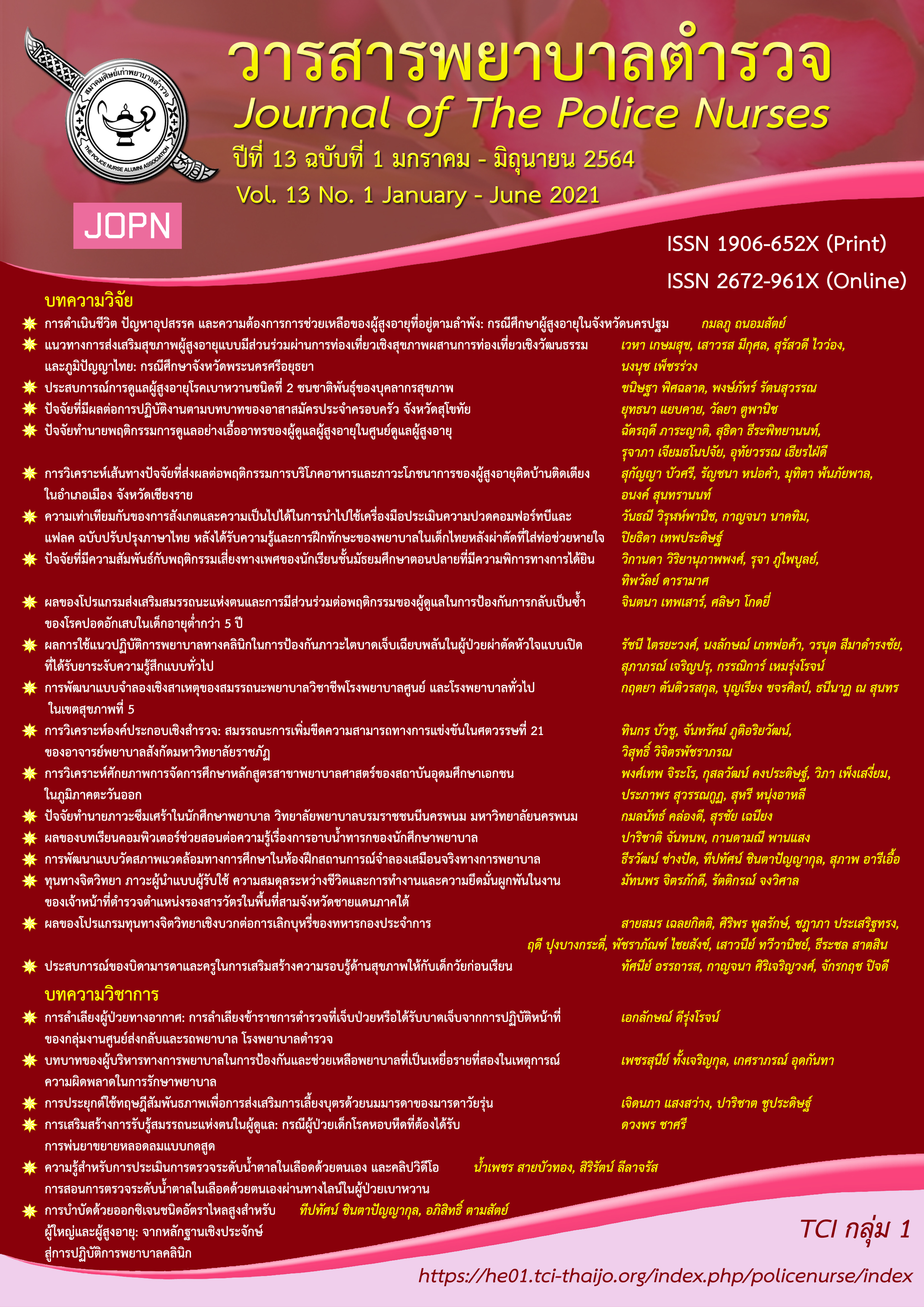ความเท่าเทียมกันของการสังเกตและความเป็นไปได้ในการนำไปใช้เครื่องมือประเมินความปวดคอมฟอร์ทบีและแฟลค ฉบับปรับปรุงภาษาไทย หลังได้รับความรู้และการฝึกทักษะ ของพยาบาลในเด็กไทยหลังผ่าตัดที่ใส่ท่อช่วยหายใจ
คำสำคัญ:
ความเท่าเทียมกันของการสังเกต, ความเป็นไปได้ในการนำไปใช้, คอมฟอร์ทบี, แฟลคบทคัดย่อ
การศึกษานี้มีวัตถุประสงค์เพื่อประเมินความเท่าเทียมกันของการสังเกตการใช้เครื่องมือประเมินความปวดคอมฟอร์ทบีและแฟลค ฉบับปรับปรุงภาษาไทย และความเป็นไปได้ในการใช้เครื่องมือประเมินความปวดทั้งสองชนิดหลังจากได้รับความรู้และการฝึกทักษะของพยาบาลในการประเมินความปวดในเด็กหลังผ่าตัดใส่ท่อช่วยหายใจ ตัวอย่าง คือ ผู้ทรงคุณวุฒิกับพยาบาลจำนวน 19 คน ในหอผู้ป่วยวิกฤตเด็ก โดยพยาบาลจะได้รับการอบรมความรู้เกี่ยวกับความปวด เครื่องมือประเมินความปวด และฝึกทักษะการประเมินความปวดโดยใช้เครื่องมือประเมินความปวดทั้งสองชนิดในเด็กหลังผ่าตัดที่ใส่เครื่องช่วยหายใจจากวีดีโอและสถาณการณ์จริงในหอผู้ป่วย จากนั้นพยาบาลแต่ละคนทำการสังเกตและประเมินความปวดเด็กหลังผ่าตัดและใส่ท่อช่วยหายใจจากชุดวีดีโอที่ผู้วิจัยเตรียมไว้ พยาบาลแต่ละคนมีอิสระในการสังเกตแต่ต้องประเมินความปวดในเวลาเดียวกัน โดยใช้เครื่องมือประเมินความปวดทั้งสองชนิด ข้อมูลที่ได้นำมาวิเคราะห์ความเที่ยงของความเท่าเทียมกันของการสังเกตระหว่างผู้ประเมินและตัวอย่างด้วยสถิติแคปปาของโคเฮน และความเป็นไปได้ในการใช้เครื่องทั้งสองชนิดโดยพิจารณาจากค่าร้อยละ
ผลการวิจัยพบว่า คะแนนสัมประสิทธิ์แคปปาโดยรวมของเครื่องมือประเมินความปวดคอมฟอร์ทบีและแฟลคฉบับปรับปรุงภาษาไทยระหว่างผู้ทรงคุณวุฒิและพยาบาลเท่ากับ .86 และ .89 ตามลำดับ ซึ่งคะแนนที่ได้จัดอยู่ในระดับดี สำหรับความเป็นไปได้ในการนำไปใช้ของเครื่องมือประเมินความปวดแฟลคฉบับปรับปรุงภาษาไทย พบว่าพยาบาลให้คะแนน 3 และ 4 รวมกันร้อยละ 100 ทุกข้อคำถาม และความเป็นไปได้ในการนำไปใช้ของเครื่องมือประเมินความปวดคอมฟอร์ทบี ฉบับปรับปรุงภาษาไทย พบว่าพยาบาลให้คะแนน 3 และ 4 ต่ำกว่าร้อยละ 70 ในข้อคำถามการนำไปใช้ในการประเมินความปวดในเด็กหลังผ่าตัดและใส่เครื่องช่วยหายใจได้เร็วและง่าย ดังนั้น ผลการศึกษาครั้งนี้ชี้ให้เห็นว่าการอบรมเชิงปฏิบัติการด้วยการสอนให้ความรู้และการฝึกทักษะการใช้เครื่องมือประเมินความปวดทั้งสองชนิดจนกระทั่งพยาบาลได้คะแนนความเท่าเทียมกันของการสังเกตผ่านเกณฑ์เป็นที่ยอมรับ คือ มากกว่าหรือเท่ากับร้อยละ 80 จะช่วยให้พยาบาลเพิ่มพูนความรู้และทักษะในการใช้เครื่องมือประเมินความปวด
ในการปฏิบัติการพยาบาลในคลีนิคได้อย่างเพียงพอและเหมาะสม
Downloads
เอกสารอ้างอิง
Ambuel, B., Hamlett, K. W., Marx. C. M., & Blumer, J. L. (1992). Assessing distress in pediatric intensive care environment: The COMFORT scale. Journal of Pediatric Psychology, 17(1), 95-109.
Bai, J., Hsu, L., Tang, Y., & Dijk, M. V. (2012). Validation of the COMFORT behavior scale and the FLACC scale for pain assessment in Chinese children after cardiac surgery. Pain Management Nursing, 13(1), 18-26. https://doi.org/10.1016/j.pmn.2010.07.002
Blakely, W. R., & Page, G., G. (2001). Pathophysiology of pain in critically ill patients. Critical Care Nursing Clinics of North America, 13(2), 167-179. https://doi.org/10.1016/s0899-5885(18)30047-9
Gélinas, C. (2010). Nurses’ evaluations of the feasibility and the clinical utility of the critical-care pain observation tool. Pain Management Nursing, 11(2), 115-125.
Gwet, K. L. (2014). Handbook of inter-rater reliability: The definition guide to measuring the extent of agreement among raters (4th ed.). Retrieved from http://www.agreestat.com/book4/9780970806284_chap6.pdf
Hamill-Ruth, R. J., & Marohn, M. L. (1999). Evaluation of pain in the critically ill patient. Critical Care Clinics, 15(1), 35-54. https://doi.org/10.1016/s0749-0704(05)70038-5
Hossain, S., Wiroonpanich, W., & Orapiriyakul, R. (2010). Nurses’ knowledge and attitude, and pain management practice of post-operative children in Bangladesh (Mater of nursing science program, Pediatric Nursing, International Program). Faculty of Nursing, Prince of Songkla University, Songkhla, Thailand.
Hurley-Wallace, A., Wood, C., Franck, L. S., Howard, R. F., & Liossi, C. (2019). Pediatric pain education for health care professionals. PAIN Reports, 4(1), e701. https://doi.org/10.1097/PR9.0000000000000701
Ismail, A. (2016). The challenges of providing effective pain management for children in the pediatric intensive care unit. Pain Management Nursing, 17(6), 372-383. https://doi.org/10.1016/j.pmn.2016.08.005.
Johansson, M., & Kokinsky, E. (2009). The COMFORT behavioral scale and the modified FLACC scale in pediatric intensive care. Nursing in Critical Care, 14(3), 122-130. https://doi.org/10.1111/j.1478-5153.2009.00323.x
Kwekkeboom, K, L., & Herr, K. (2001). Assessment of pain in the critically ill. Critical Care Nursing Clinics of North America, 13(2), 181-194. https://doi.org/10.1016/S0899-5885(18)30048-0
Lellan, K. M. (2004). Postoperative pain: Strategy for improving patient experiences. Journal of Advanced Nursing, 46(2), 179-185. http://doi.org/10.1111/j.1365-2648.2003.02977.x.
Linton, S. L., & Shaw, W. S. (2011). Impact of psychological factors in the experience of pain. Physical Therapy, 91(5), 700-711. https://doi.org/10.2522/ptj.20100330
Manworren, R. C. B., & Stinson, J. (2016). Pediatric pain measurement, assessment, and evaluation. Seminars in Pediatric Neurology, 23(3), 189-200. http://dx.doi.org/10.1016/j.spen.2016.10.001
Mayae, H., Wiroonpanich, W., & Wattanasit, P. (2020). Relationship between knowledge and attitude and pain management of nurses in Southern Pediatric Intensive Care Unit. The Southern College Network Journal of Nursing and Public Health, 7(3), 47-57.
Merkel, S. I., Voepel-Lewis, T., Shayevitz, J. R., & Malviya, S. (1997). The FLACC: A behavioral scale for scoring postoperative pain in young children. Pediatric Nursing, 23(3), 293-297.
Michaels, T. K., Hubbartt, E., Carroll, S. A., & Hudson-Barr, D. (2007). Evaluating an educational approach to improve pain assessment in hospitalized patients. Journal of Nursing Care Quality, 22(3), 260-265. http://dx.doi.org/10.1097/01.NCQ.0000277784.14310.66
Morrison, R. S., Meier, D. E., Fischberg, D., Moore, C., Degenholtz, H., Litke, A., Siu, A. L. (2006). Improving the management of pain in hospitalized adults. Archives of Internal Medicine, 166(9), 1033-1039. http://dx.doi.org/10.1001/archinte.166.9.1033
Narktim, K., Wiroonpanich, W., & Wattanasit, P. (2018). Comparison of the properties of pain assessment tools between the COMFORT-B scale and the modified FLACC scale in ventilated sedated children during suctioning. Songklanagarind Journal of Nursing, 38(1), 90-102.
Oakes, L. L. (2011). Compact clinical guide to infant and children pain management. New York, NY: Springer.
Prasanwon, K., Patoomwan, A., & Pookboonmee, R. (2018). Nurses’ knowledge, attitude, and nursing practices for pain management for postoperative children. Ramathibodi Nursing Journal, 24(1), 37-50.
Puntillo, K. A., Miaskowski, C., Kehrle, S., Gleeson, S., & Nye, P. (1997). Relationship between behavioral and psychological indicators of pain, critical care patients’ self-reports of pain, and opioid administration. Critical Care Medicine, 25(7), 1159-1166. http://dx.doi.org/10.1097/00003246-199707000-00017
Ramelet, A-S., Abu-Saad, H. H., Rees, N., & McDonald, S. (2004). The challenges of pain measurements in critically ill young children: A comprehensive review. Australian Critical Care, 17(1), 33-45.
Schwartz, N. E. (1975). Nutritional knowledge, attitude and practice of high school graduated. Journal of the American Dietetic Association, 66(1), 28-31.
Sheskin, D. J. (2011). Handbook of parametric and nonparametric statistic procedures (5th ed.). New York, NY, Washington: Taylor and Francis Group.
van Dijk, M. V., Bouwmeester, N. J., Duivenvoorden, H. J., Koot, H. M., Tibboel, D., Passchier, J., & de Boer, J. B. (2002). Efficacy of continuous versus intermittent morphine administration after major surgery in 0-3-year-old infants: A double-blind randomized controlled trial. Pain, 98, 305-313.
van Dijk, M. V., de Boer, J. B., Koot, H. M., Tibboel, D., Passchier, J., & Duivenvoorden, H. J. (2000). The reliability and validity of the COMFORT scale as a postoperative pain instrument in 0 to 3-year-old infants. Pain, 84, 367-377.
Voepel-Lewis, T., Merkel, S., Tait, A. R., Trzcinka, A., & Malviya, S. (2002). The reliability and validity of the face, legs, activity, cry, consolability observational tool as a measure of pain in children with cognitive impairment. Anesthesia & Analgesia, 95(5), 1224-1229.
Watt-Watson, J. H. (1997). Relationship between nurses’ empathic responses and pain management in acute care. Retrieved from http://www.collectionscanada.ca/obj/s4/f2/dsk2/ftp02/NQ28078.pdf
ดาวน์โหลด
เผยแพร่แล้ว
รูปแบบการอ้างอิง
ฉบับ
ประเภทบทความ
สัญญาอนุญาต
ผลงานที่ได้ตีพิมพ์แล้วจะเป็นลิขสิทธิ์ของวารสารพยาบาลตำรวจ















